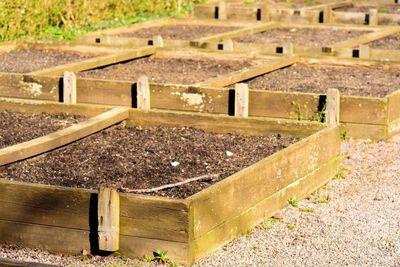About Soil Depth for Raised Beds
Raised beds can be framed or unframed. Unframed raised beds are often called berms and are simply garden beds made of mounded up soil. These are most commonly created for ornamental landscape beds, not fruit or vegetable gardens. Unframed raised bed soil depth depends on what plants will be grown, what the soil conditions under the berm are, and what the desired aesthetic effect is. Trees, shrubs, ornamental grasses, and perennials can have root depths anywhere between 6 inches (15 cm.) to 15 feet (5 m.) or more. Tilling the soil beneath any raised bed will loosen it up so that plant roots can reach the depths that they need for proper nutrient and water uptake. In locations where the soil is of such poor quality that it cannot be tilled or loosened, raised beds or berms will need to be created higher, resulting in more soil needing to be brought in.
How Deep to Fill a Raised Bed
Framed raised beds are frequently used for vegetable gardening. The most common depth of raised beds is 11 inches (28 cm.) because this is the height of two 2×6 inch boards, which is commonly used to frame raised beds. Soil and compost are then filled into the raised beds to a depth just a few inches (8 cm.) below its rim. A few flaws with this are that while many vegetable plants need a depth of 12 to 24 inches (31-61 cm.) for good root development, rabbits can still get into beds that are less than 2 feet (61 cm.) high, and a garden 11 inches (28 cm.) high still requires a lot of bending, kneeling, and squatting for the gardener. If the soil beneath a raised bed is not suitable for plant roots, the bed should be created high enough to accommodate the plants. The following plants can have 12 to 18 inch (31-46 cm.) roots:
Arugula Broccoli Brussels sprouts Cabbage Cauliflower Celery Corn Chives Garlic Kohlrabi Lettuce Onions Radishes Spinach Strawberries
Root depth from 18 to 24 inches (46-61 cm.) should be expected for:
Beans Beets Cantaloupe Carrots Cucumber Eggplant Kale Peas Peppers Squash Turnips Potatoes
Then there are those having much deeper root systems of 24 to 36 inches (61-91 cm.). These may include:
Artichoke Asparagus Okra Parsnips Pumpkin Rhubarb Sweet potatoes Tomatoes Watermelon
Decide on the type of soil for your raised bed. Bulk soil is most often sold by the yard. To calculate how many yards are needed to fill a raised bed, measure the length, width, and depth of the bed in feet (you can convert inches to feet by dividing them by 12). Multiply the length x width x depth. Then divide this number by 27, which is how many cubic feet are in a yard of soil. The answer is how many yards of soil you will need. Keep in mind that you will most likely want to mix in compost or other organic matter with regular topsoil. Also, fill raised garden beds to a few inches (8 cm.) below the rim to leave room for mulch or straw.
